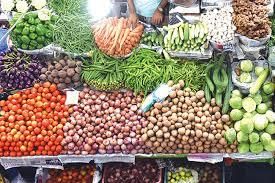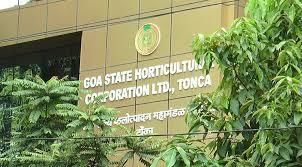GPSC (Goa) Exam > GPSC (Goa) Notes > Goa State PSC (GPSC) Preparation > Goa: Horticulture
Goa: Horticulture | Goa State PSC (GPSC) Preparation - GPSC (Goa) PDF Download
Overview of Horticulture in Goa

- Horticulture in Goa encompasses various types of crops such as fruits, vegetables, tubers, ornamental plants, medicinal herbs, spices, and plantation crops.
- New additions like mushrooms, bamboo, and beekeeping have broadened the scope of horticulture, aiming to enhance crop productivity.
- Initially focused on achieving food self-sufficiency, horticulture now plays a crucial role in agriculture, offering farmers diverse crop choices for cultivation.
Contribution of Horticulture Sector
- The horticulture sector contributes significantly to Goa's economy, accounting for around 28% of the GDP from approximately 13.08% of agricultural land.
- Over the years, India has made strides in horticultural research and development, establishing itself as a leading producer of various crops globally.
- Through strategic research, technology adoption, and policy support, horticulture has become a sustainable and profitable venture, especially for small-scale farmers.
Opportunities and Growth Potential
- Horticulture offers ample opportunities for the establishment of agro-industries, which in turn create significant employment prospects.
- Entrepreneurs are increasingly showing interest in horticulture as a commercial venture, indicating a growing market potential in the sector.
- With the right focus on research, technology, and policy, the horticulture industry in Goa has a promising future for expansion and prosperity.
Key Achievements in Indian Horticulture
- India has emerged as a major producer of fruits, vegetables, cashews, tea, spices, coconuts, rubber, and coffee on the global stage.
- Strategic initiatives and advancements have positioned India as a significant player in the global horticulture market, attracting attention from entrepreneurs and investors.
- The synergy between research, technology, and agricultural practices has transformed horticulture into a sustainable and profitable venture for farmers of all scales.
Future Prospects and Recommendations
- The horticulture sector in Goa has immense growth potential and can further contribute to the state's economic development.
- Continuous investment in research, technology, and skill development is crucial for ensuring the sustainable growth of the horticulture industry.
- Government support and favorable policies can play a significant role in fostering innovation and entrepreneurship in the horticulture sector.
Horticulture of Goa
- Historically, horticulture encompasses various areas of study such as pomology (fruit culture), olericulture (vegetable culture), floriculture (cultivation of decorative crops), and post-harvest technology (management of produce post-harvest).
- Over time, this field has expanded to include diverse crops like mushrooms, bamboo, and plantation crops such as tea, coffee, and rubber. The horticulture division also oversees beekeeping to enhance crop productivity through improved fertilization.
Evolution of Horticulture
- The scope of horticulture has broadened to include a variety of crops beyond traditional fruits and vegetables.
- It now encompasses the cultivation and management of ornamental, tuber, medicinal, aromatic crops, spices, as well as plantation crops.
- The focus extends to processing, value addition, and marketing of these crops.
Goa State Horticulture Development Corporation (GSHDC)

- The GSHDC was established to enhance infrastructure for vegetable and flower cultivation in Goa, promoting agricultural development in the region. It has significantly contributed to vegetable farming across 92 hectares in 10 talukas, involving 55 groups comprising 1500 farmers.
- Notably, the initiative has been particularly successful in all talukas except Mormugao, where progress remains slow. The Corporation facilitates a marketing outlet for every unit of cultivated land, ensuring farmers have a direct channel for their produce. Additionally, the Corporation covers the rent for these outlets, up to a maximum of Rs 2000 per month.
Impact of GSHDC
- GSHDC has provided essential support for vegetable and flower cultivation in Goa, accelerating agricultural growth.
- It has increased farmer participation and improved market access for agricultural produce.
- The initiative has enhanced the economic prospects of farmers by ensuring a reliable marketing outlet for their crops.
Transformation of Vegetable Supply Chain in Goa
- The traditional reliance on Belgaum for vegetable supply in Goa is gradually shifting, as reported by the Goa State Horticulture Department.
- The Horticulture Corporation of the state has played a pivotal role in encouraging local farmers to engage in vegetable cultivation, leading to a significant increase in domestic production.
The Shift in Procurement Patterns
- Previously, the majority of vegetables in Goa were procured from Belgaum, but now the state is reducing its dependency on this external source.
- The Horticulture Corporation's initiatives have resulted in a substantial drop in the quantity of vegetables sourced from Belgaum.
Rise in Local Vegetable Production
- Despite Goa's daily vegetable requirement being approximately 300 tons, the corporation managed to procure around 200 tons of locally grown vegetables last year alone.
- This marks a significant increase compared to the production levels of the past five years, which averaged around 24 tons annually.
- The total production in the state is estimated to exceed 500 tons, with many farmers opting to sell their produce directly to consumers.
Support for Farmers
- The Horticulture Corporation is providing financial assistance of Rs. 40,000 per hectare to farmers for various activities such as fencing, well construction, and pump purchase.
- Additionally, the corporation is offering seeds to farmers at subsidized rates, further incentivizing local vegetable cultivation.
Question for Goa: HorticultureTry yourself: What is the primary role of the Goa State Horticulture Development Corporation (GSHDC)?View Solution
Goa State Horticultural Corporation

- Goa's agricultural sector presents opportunities for cultivating high-quality chillies and onions, with a recent surge in the cultivation of various vegetables such as gourd vine, cluster beans, chillies, cucumbers, brinjals, ladyfingers, tomatoes, and leafy greens.
- Local farmers often choose to sell certain vegetables like brinjals and cucumbers directly to consumers instead of to the corporation due to better rates, resulting in increased profits.
Background of Goa State Horticultural Corporation
- The Goa State Horticultural Corporation is actively involved in promoting and selling agricultural produce, aiming to support farmers in marketing their products and reduce the state's reliance on neighboring states for agricultural commodities.
Evolution of GSHCL
- Originally established in 1993 as the Goa Farming and Plantation Crops Development Corporation Ltd, the organization was later renamed Goa State Horticultural Corporation Ltd in 1996.
Vegetable Cultivation in Goa
- Traditionally, Goan farmers primarily cultivated vegetables for local consumption, with any surplus produce being sold locally. The state used to depend on neighboring states like Karnataka and Maharashtra for vegetable supplies.
Current Agricultural Scenario
- Currently, Goa requires around 300-400 metric tons of vegetables daily, a demand that was previously fulfilled by imports from neighboring states. Certain crops like potato, tomato, cabbage, and carrot cannot be grown extensively in Goa due to its agro-climatic conditions, necessitating their import.
Hybrid Vegetable Cultivation Program: 2011-12
- In the year 2011-12, the Corporation initiated a program to promote native cultivation of vegetables by introducing hybrid seedlings of various vegetables in seed trays/pro-trays, along with a complete package of practices and necessary nutrients for farmers.
- Additionally, farmers were provided with different vegetable seeds and a guaranteed market for their produce by the Corporation.
Vegetable Shops Program
- In 2008, the State Government implemented a program to control the soaring prices of vegetables by offering ten essential types of vegetables at subsidized rates to the public across the State.
- To execute this initiative, the Corporation outsourced networks of vegetable shops to farmers' groups and individuals.
Impact and Expansion
- The control program effectively influenced vegetable prices in the open market.
- The number of subsidized vegetable shops increased from 427 in 2012 to 900, sponsored by the Corporation, creating self-employment opportunities for 900 families.
- The State meets its local vegetable demand by importing from Belgaum wholesale market, importing around 180-200 tons of vegetables daily for distribution through the network of shops.
Overview of Vegetable Sales Transformation
- Initially, there was some opposition as individuals were not allowed to directly sell vegetables. To address this, steel carts were acquired and leased to them at a minimal cost.
- They source vegetables from the wholesale market through suppliers in Belgaum and distribute them to the public via 900 vendors who receive a reasonable commission.
- Government grants aim to stabilize market prices by covering overhead costs. Our pricing is flexible, depending on the rates at which we procure from the wholesale market.
Seed Distribution
- Farmers receive vegetable seeds free of charge from the State Department of Agriculture. Some select varieties are sold at subsidized rates, making them affordable for farmers.
- Seeds are purchased in bulk from recognized producers located in Pune, Mumbai, and Belgaum.
Introduction of New Crops and Support
- The initiative introduced the production and sale of green chillies in the state, followed by the inclusion of crops like ridge gourd, legumes, okra, chili, and coriander, with seedlings provided accordingly.
- This led to a significant growth in commercial vegetable cultivation in the state.
- Prior to this, farmer groups received 100% support for infrastructure development, such as fencing, pumps, and pipelines, with assistance amounting to Rs. 40,000 per hectare.
Procurement Centers
Procurement centers were established to address the lack of market access for native farmers, who previously cultivated primarily for self-consumption rather than for commercial purposes. Awareness about certain crops like green chilies was also lacking, leading to a common practice of purchasing them from the market for daily use. To incentivize farmers to grow vegetables for commercial purposes, a network of 18 procurement centers was set up across the state.
- Each center is equipped with digital scales and two staff members authorized to purchase vegetables from farmers.
- The establishment of these centers has played a crucial role in building farmers' trust in the promise of a reliable market.
- All vegetables procured from farmers are distributed through 900 retail outlets after being sorted and packed in 5kg or 10kg packages based on vendor requirements.
- Farmers are required to inform the procurement centers in advance about the produce they intend to sell. Upon arrival, the quality of the produce is assessed, weighed, and an acknowledgment slip is provided to the farmer.
- Payment for the produce is processed and directly transferred to the farmers' bank accounts via RTGS within a month.
Exports
- The state's efforts have yielded positive outcomes, leading to the exploration of export opportunities for agricultural products. Notably, crops such as chilies, okra, cluster beans, and eggplants have shown promising growth in our region.
State's Agricultural Developments
- Successful Agricultural Ventures: The state's efforts have borne fruit, leading to successful ventures in exports. Notably, chili production, along with crops like okra, cluster beans, and eggplant, are thriving.
Coconut Plucking Service Initiative
- Addressing Labor Shortages: Due to Goa's socio-economic progress, there is a significant shortage of labor, particularly for tasks like coconut plucking. To mitigate this challenge faced by coconut farmers, the GSHCL has deployed 25 trained coconut pluckers. These pluckers are available for booking at a reasonable fee, receiving both a fixed wage and daily incentives for their work.
Future Agricultural Plans
- The government has earmarked land in Thivim, Mapusa, for setting up sorting, grading, and packaging facilities for imported vegetables and fruits. Additionally, storage facilities for onions, fruits, and potatoes will be developed.
- Ripening chambers will be implemented to ensure certified ripening processes. Furthermore, there are plans to establish small-scale food processing units to produce value-added products such as sauces, pickles, and dried chilies.
Ripening Strategy and Diversification Plan
- Ripening chambers play a crucial role in ensuring certified ripening methods.
- Expansion plans include setting up small-scale food processing units to produce value-added products like condiments, pickles, and dried chilies.
Development of Ripening Facilities
- Ensuring the implementation of certified ripening processes through dedicated chambers.
- Example: Employing ethylene gas to regulate fruit ripening in a controlled environment.
Small-Scale Food Processing Units
- Establishing units for the production of secondary products to enhance market offerings.
- Example: Creating a line of artisanal pickles using locally sourced ingredients.
Question for Goa: HorticultureTry yourself: Which initiative was introduced to control the soaring prices of vegetables in Goa?View Solution
The document Goa: Horticulture | Goa State PSC (GPSC) Preparation - GPSC (Goa) is a part of the GPSC (Goa) Course Goa State PSC (GPSC) Preparation.
All you need of GPSC (Goa) at this link: GPSC (Goa)
Related Searches




















